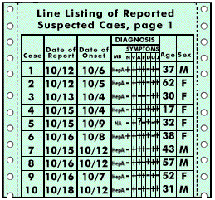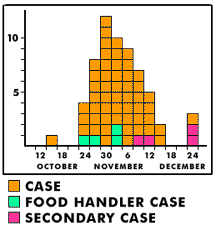|
|
 |


|

A number of people are sick and no one knows why. The local government
invites CDC to come and investigate. CDC sends a team of disease detectives
to try and discover the cause of the disease outbreak.
What is causing the outbreak? People could be sick from food they ate,
water they drank, or something in their environment. Maybe they were bitten
by an insect or animal. The disease detectives are specially trained and
equipped to solve this mystery.
This specimen collection tent is equipped with many of the tools the
disease detectives will need to uncover clues about what is making people
sick. Here you see a disease detective about to take blood from a patient.
Click on an area in the photo to learn more about how disease detectives
work.
|
Top
 |
Spot Map
The disease detective drew this chart to show where each
sick person lives. Knowing this may give clues to what is causing the
outbreak. This type of chart is called a spot-map.
Line listings and histograms
are other ways detectives piece the clues together. |
Top
 |
Line Listing
As detectives learn about who is sick, they add key pieces
of information about each person to a line listing. Each row or line
represents one sick person. In the line listing below, the information
collected for each person includes the day they reported being sick, the day
they first felt sick (date of onset), and their symptoms, age, and sex.
How old are most of the people who are sick? Are they young
or old? Male or female? Do you see a pattern? The line listing is a good
tool for detectives to learn more about who is getting sick. If they see a
pattern such as mostly teenagers being sick, for instance, they would try to
figure out why the disease is affecting that age group.
spot map | histograms |
Top
 |
Histogram
A histogram shows how many people got sick and when they
got sick. Each square in the histogram below represents a sick person. What
was the day when the most people were sick? This is when the outbreak
peaked.
Knowing when an outbreak started, when it ended, and when
it peaked helps the disease detective narrow down the kinds of diseases that
could have caused the outbreak.
spot map | line listings map |
Top
 |
Spot Map
Spots are placed on a map to show where each sick person
lives or works. The spots could also be used to show where key events have
happened, such as where each sick person ate lunch. The location of the
spots may give detectives clues to the cause of an outbreak. When the spots
are clustered in one area, that may mean that something about that area is
causing the outbreak.
What clues do you see in the spot map? |
Top
 |
Disease Detective
A disease detective is a person who is trained at CDC to
figure out the who, when, where, and what of disease
outbreaks. These detectives use their knowledge and skills in medicine,
statistics, and epidemiology.
During a field investigation, disease detectives must be
sure to take care of themselves. Wearing protective goggles keeps debris and
harmful bacteria out of their eyes and a wide-brimmed hat protects them from
the sun. |
Top
 |
Camera
This disease detective uses the camera to take pictures of
the surroundings. There may be a clue to the cause of the outbreak right
under his nose!
Special packages and labels are used to safely store and
ship the specimens that are collected from patients. Take a closer look.
What do you think is in that container? |
Top
 |
Computer
This disease detective collects information to figure out
the cause of the outbreak. Tools like the portable computer and calculator
help the detective sift through the information.
See the insect repellent and sun screen? Why are they
important here? |
Top
 |
Cooler
What do you think is in the detectiveís cooler? Itís
probably not what you think.
The cooler contains dry ice to keep specimens cold, if
needed.
Safe drinking water is often a problem in the places where
a disease detective travels. This detective brought his own fresh drinking
water in the green jug. |
|




